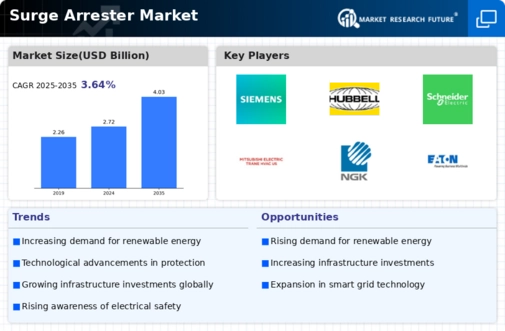Top Industry Leaders in the Surge Arrester Market

*Disclaimer: List of key companies in no particular order
The Surge Arrester Market is witnessing a dynamic and competitive landscape, driven by the escalating demand for reliable power protection solutions. This comprehensive analysis explores the key players, their strategies, factors influencing market share, and emerging trends shaping the future of the industry.
Key Players and Strategies: The surge arrester market is home to established players and emerging companies, each employing distinct strategies to gain a competitive edge. Notable players include Siemens (Germany), E. Oil & Gas (U.S.), Hubbell (U.S.), Schneider Electric (France), Mitsubishi Electric (Japan), G. Power (India), NGK Insulators (Japan), ABB (Switzerland), Eaton (Republic of Ireland), Legrand S.A (France), Emerson Electric (U.S.), HAKEL spol. Sr. (Czech Republic), Vertiv (U.S.), E. Connectivity (Switzerland), Lamco (India), Leviton Manufacturing (U.S.), Raycap Corporation S.A. (U.S.), and others.
ABB, a leading player, prioritizes innovation and product development, employing strategies such as strategic acquisitions, technological advancements, and market expansion. Eaton Corporation, another prominent participant, focuses on reliability, performance, and customized solutions to cater to specific needs. Siemens, renowned for its engineering expertise, emphasizes technology leadership and digitalization, with a focus on smart grid solutions. Schneider Electric, committed to sustainability, expands into developing markets and offers eco-friendly surge arresters.
Tyco Electronics, known for quality and safety, concentrates on product certification and compliance with international standards. Their strategy involves strategic partnerships and expanding the product portfolio to cater to diverse markets.
Factors Influencing Market Share: Several factors contribute to the analysis of market share within the surge arrester market. The breadth and depth of a company's product portfolio, geographic reach, technological expertise, brand reputation, and competitive pricing strategies are critical considerations.
Companies offering a diverse range of surge arresters for various applications tend to secure larger market shares. A strong market presence in key regions and an efficient distribution network provide a competitive advantage. Continuous investment in research and development for technological advancements ensures sustained market share. A proven brand reputation for delivering quality products and services builds customer loyalty, while competitive pricing strategies attract a wider customer base.
New and Emerging Trends: The surge arrester market is evolving with new and emerging trends that are reshaping the industry:
Smart Surge Arresters: Integration of smart technologies like sensors and communication modules provides real-time performance data, enabling remote monitoring and diagnostics for improved grid reliability and maintenance efficiency.
Composite Materials: The use of materials like silicon rubber is gaining traction due to superior dielectric properties and lighter weight, offering enhanced performance and longer lifespan.
Modular Design: Development of modular surge arresters facilitates easier installation, maintenance, and replacement, particularly beneficial for applications requiring flexibility and scalability.
Surge Arrester Monitoring Systems: Increased adoption of monitoring systems enables proactive maintenance and timely detection of potential failures, preventing power outages and ensuring grid stability.
Sustainability Focus: Growing emphasis on sustainability is driving the development of eco-friendly surge arresters made from recycled materials, designed for energy-efficient operations.
Overall Competitive Scenario: The surge arrester market is experiencing moderate growth, fueled by the rising demand for reliable power protection solutions. Established players adopt various strategies, including product innovation, strategic acquisitions, and market expansion, to vie for market share. New trends such as smart surge arresters and composite materials create opportunities for disruptive players. The competitive scenario is expected to remain dynamic, with a continued focus on technology leadership, customer-centric solutions, and sustainability.
Industry Developments and Latest Updates: Recent developments among key players highlight ongoing advancements in the surge arrester market:
Siemens (Germany):
- August 2023: Launched the SENTINEL SPS surge arrester series for low-voltage applications, featuring improved energy absorption and a compact design.
E. Oil & Gas (U.S.):
- October 2023: Unveiled a new line of high-voltage surge arresters specifically designed for oil and gas facilities.
Hubbell (U.S.):
- November 2023: Introduced the SurgeProtector Plus+ series of surge arresters with integrated surge monitoring capabilities.
Schneider Electric (France):
- October 2023: Released a white paper on the importance of surge protection for critical infrastructure.
Mitsubishi Electric (Japan):
- September 2023: Showcased its latest surge arrester technologies at the CIGRE international conference on electricity.
The industry's competitive landscape, marked by innovation and evolving trends, presents opportunities for companies that can adapt, innovate, and offer value-driven solutions. Continuous investment in technology, a focus on sustainability, and strategic partnerships will be essential for success in this dynamic and competitive market.

